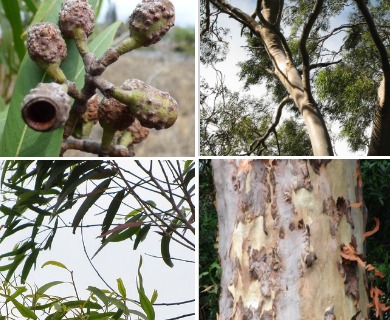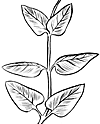Lemonscented Gum
Corymbia citriodora
Eucalyptus-Like family (Myrtaceae)
Post-Cook introduction
Easily recognized by the strong lemon odor of crushed foliage, this eucalypt grows better at lower altitude than most of the others introduced to Hawaii. A handsome large tree 80–160 ft (24–48 ) high, with straight trunk 2–4 ft (0.6–1.2 ) in diameter. or thin. Bark smooth, gray, peeling in thin or patches and becoming mottled, exposing whitish or faintly bluish inner layer with powdery surface, appearing dimpled; on large trunks dark gray. Twigs slender, slightly flattened, light green, brownish tinged.

Forest And Kim Starr
Flower clusters () lateral and to 2 1⁄2 inches (6 ) long, branched. Flowers many, 3–5 together on equal stalks (), about 1⁄2 inch (13 ) across the many spreading white Buds are short-stalked, egg-shaped, about 1⁄2 inch (13 ) long and 5⁄16 inch (8 ) wide, lid short, half-round with short point.
Seed capsules egg-shaped or urn-shaped, narrowed into short neck, 1⁄2 inch (13 ) long and 5⁄16–3⁄8 inch (8–10 ) wide, brown with scattered raised dots, with wide sunken and enclosed valves, opening by three narrow lines. Seeds are few, irregularly elliptical, more than 1⁄8 inch (3 ) long, blackish, and also many smaller ones nonfunctional.
Wood light brown to gray brown, very heavy ( gr. 0.85), very hard, strong and very tough; moderately durable to durable; straight or wavy grain. Works easily for a wood of its density. It has been used in Hawaii for boat framing, sugar mill conveyor belt slats, and general heavy construction. Also used on a small in Hawaii, and more extensively in South Africa, for handle stock. Relatively stable for a eucalypt, very slow drying, but maintains its shape well in drying without collapse or serious checking.
In Australia, it is considered a first-class saw timber with a wide range of uses including general and heavy construction and tool handles.
In Hawaii, commonly seen planted in the lowlands. There is an avenue of these trees at the entrance to Ualakaa Park (Round Top) on Oahu. It is the principal tree bordering Wahiawa Reservoir. The Division of Forestry had planted 127,000 trees in the forest reserves by 1960. It was frequently used on the island of Hawaii to make boundaries of various land ownerships and fence lines within the reserves and long single rows of the tree can be seen running through the forest near Hilo. A large tree grows alongside H-1 Freeway in Moanalua Gardens.
Strong lemon odor from the essential oil citronellal is produced by crushing the foliage. Leaves when distilled yield this oil, which is used as perfume for soap. On a warm still day in Hawaii, the smell near the trees can be almost overpowering.
Special areas
Wahiawa, Tantalus, Pepeekeo
Champion
Height 98 ft (30.0 ), c.b.h. 16 ft (4.9 ), spread 90 ft (27.4 ). Kaumana Drive, Hilo, Hawaii (1968).
Range
Northeastern Australia (Queensland), from coast to more than 200 miles (322 km) inland. Usually mixed with other eucalypts.
Often planted as an attractive ornamental in Australia, but the is too sparse for shelterbelts. Adapted to summer rainfall climate and very extensively planted worldwide in warm monsoon tropics.
Other common names
lemon-scented-gum, spotted-gum, lemon-scented irongum (Australia)
Botanical
Eucalyptus citriodora Hook., Eucalyptus maculata Hook. var. citriodora (Hook.) Bailey




